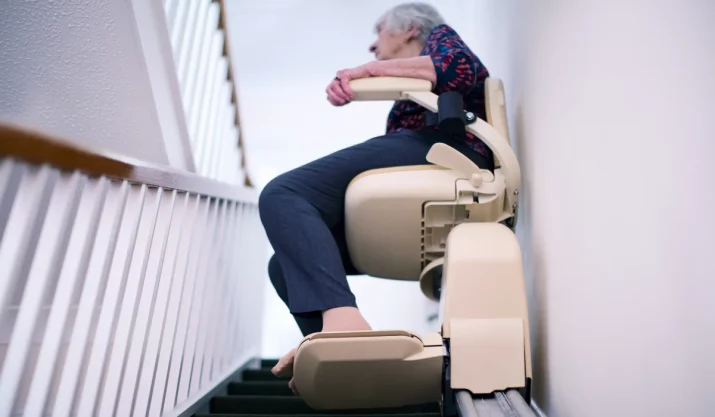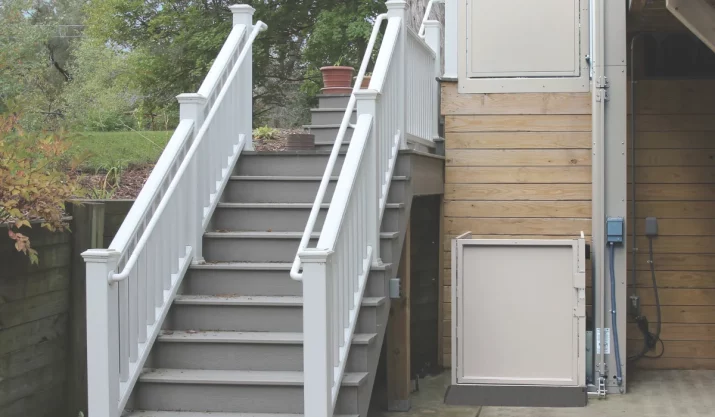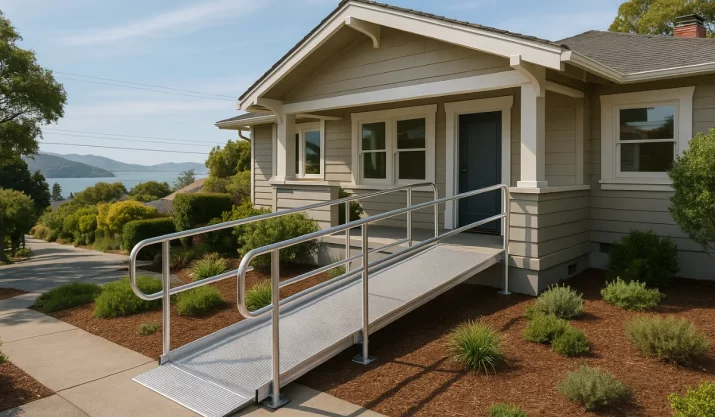Swivel Seats vs. Folding Rails: The Best Stair Lift Features for Small Staircases

Table of Contents
- Key takeaways
- Why a Swivel Seat Matters Most for Narrow Staircases
- How folding rails save space at the bottom of the stairs
- Balancing safety features with functionality
- Choosing the correct type of stairlift for small spaces
- Other space-saving stair lift features
- The importance of professional installation
- Making stair lift features work for you
- FAQs
Many California homes, especially older ones in cities like San Francisco, Pasadena, and Los Angeles, have narrow staircases that feel cramped and steep. These staircases can make everyday mobility a challenge, particularly for older adults or anyone with limited strength. Installing a stair lift or chair lift can make life easier, but choosing the wrong model can introduce new safety or space issues.
Standard stair lifts often feel bulky, blocking hallways and reducing space for family members. That’s why focusing on the best stairlift features is essential, as the right chair lift design will keep your home safe, functional, and comfortable.
In this guide, we’ll explain why a swivel seat and a folding rail matter most in small spaces, what other safety features to consider, and how to choose the right stair lift for your home.
Key takeaways
- A swivel seat makes it safe and easy to exit at the top of narrow stairs.
- A foldable or folding rail clears the bottom of the stairs and prevents tripping hazards.
- The best stairlift blends safety features with daily functionality.
- Professional installation ensures a perfect fit, protects your warranty, and maximizes reliability.
Why a Swivel Seat Matters Most for Narrow Staircases
A swivel seat is one of the best stair lift features for older adults and people with mobility challenges. Instead of stepping off sideways at the top of narrow stairs, the seat rotates so you can safely step onto the landing.
A swivel seat lowers fall risk, especially for people with arthritis, balance issues, or limited flexibility. On steep, narrow stairs, that minor adjustment makes a big difference.
Many stairlift models from trusted brands like Bruno, Harmar, Handicare, and Acorn offer swivel seats in two versions:
- Manual swivel seat: Budget-friendly, operated by pulling a simple lever.
- Powered swivel seat: Best for users with weak or limited arm strength, offering push-button rotation.
When paired with armrests, seat belts, and sturdy handrails, a swivel seat makes stair lift use safer. In homes where the staircase ends near a doorway or hallway, this feature helps keep users stable during transfers.
On curved stair lifts, you can add options that let the swivel seat adjust to tricky layouts, slim rails, or a tight curve along the wall.
How folding rails save space at the bottom of the stairs
While a swivel seat improves safety at the top landing, a folding rail addresses space at the bottom of the stairs. In many California homes, staircases end near entryways or walkways. A fixed rail can block paths and create tripping hazards for family members.
That’s where folding rails help. You can lift or fold them away when the stair lift isn’t in use. Some models fold by hand, while others fold automatically as the chair parks.
Pairing a folding rail with other space-saving features, like a folding footrest and armrest, creates compact stairlifts that take up less room. For households with straight staircases, these minor adjustments can make the difference between a safe, functional space and a constant obstacle.
Balancing safety features with functionality
A swivel seat and a folding rail solve two common problems, but the best stairlift should deliver a complete package of safety features. Look for models with:
- Safety sensors that stop the lift if something blocks the track.
- Weight capacity and weight limit that match your body and mobility equipment.
- A strong warranty covering parts and service, giving you long-term peace of mind.
In California, rail systems need to handle more than everyday use. With frequent earthquakes, sturdy designs and reliable safety stops are essential. Even during a power outage, many stairlift models include battery backup, ensuring the lift remains usable when you need it most.
Choosing the correct type of stairlift for small spaces
Every home is different, and the type of stairlift you need depends on your staircase:
- Straight staircases: A straight stairlift is the most affordable and common choice.
- Curved staircases: Homes with multiple landings or a curved rail require custom-built curved stairlifts.
- Outdoor stair lifts: Ideal for porches, garden steps, or exterior entries, featuring weather-resistant upholstery and durable rails.
- Very narrow stairs may require a standing stairlifts, which allow you to ride upright, or a platform lift for wheelchair use.
Some homeowners compare stair lifts with home elevators when planning for long-term accessibility. Elevators can handle more people and equipment, but they cost much more and require significant renovation. A stairlift remains the most cost-effective and practical option for most households.
Other space-saving stair lift features
Beyond swivel seats and folding rails, other stair lift features help maximize space and comfort:
- Folding footrests and armrests: Keep the lift slim when parked.
- Slim rail design: Reduces the visual footprint on narrow staircases.
- Custom upholstery: Let your stairlift blend with your décor.
- Remote controls: Allow you to send or call the lift, making it easier to share between family members.
These features work together to create compact stairlifts that improve safety without making your home feel cluttered.
The importance of professional installation
Proper stair lift installation is just as important as choosing the right model. A professional installer makes sure the lift fits your staircase, matches the width, and works safely.
The installation process usually includes:
- Measuring your stairs and reviewing rail design.
- Checking your weight limit and specific needs.
- Installing the rail and chair for a perfect fit.
- Testing safety sensors, seat belts, and backup systems.
- Walking you through daily use and maintenance.
A professional job also protects your warranty. If you choose a trusted provider, you’ll receive ongoing maintenance, keeping your lift running smoothly and reducing long-term stairlift costs.
Making stair lift features work for you
When choosing between a swivel seat and a folding rail, consider whether you need more assistance at the top landing or the bottom of the stairs. For many homeowners, the ideal choice is a chair lift that offers both.
At California Mobility, we help families match the right stair lift features to their home.
Contact us today or request a free quote, and our specialists will help you find a chair lift with the right safety features, space-saving design, and reliable performance to make daily life easier.








